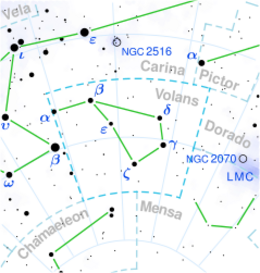Astronomy:Alpha Volantis
| Observation data Equinox J2000.0]] (ICRS) | |
|---|---|
| Constellation | Volans |
| Right ascension | 09h 02m 26.79592s[1] |
| Declination | −66° 23′ 45.8727″[1] |
| Apparent magnitude (V) | +4.00[2] |
| Characteristics | |
| Spectral type | kA3hA5mA5 V[3] |
| U−B color index | +0.13[2] |
| B−V color index | +0.14[2] |
| Astrometry | |
| Radial velocity (Rv) | +4.9[4] km/s |
| Proper motion (μ) | RA: −2.00[1] mas/yr Dec.: +95.51[1] mas/yr |
| Parallax (π) | 26.11 ± 0.12[1] mas |
| Distance | 124.9 ± 0.6 ly (38.3 ± 0.2 pc) |
| Absolute magnitude (MV) | +1.60[5] |
| Orbit[6] | |
| Period (P) | 0.652 ± 0.001 yr |
| Semi-major axis (a) | 0.0321 ± 0.0013″ |
| Eccentricity (e) | 0.041 ± 0.038 |
| Inclination (i) | 101.9 ± 2.3° |
| Longitude of the node (Ω) | 105.3 ± 1.4° |
| Periastron epoch (T) | 2015.593 ± 0.063 |
| Argument of periastron (ω) (secondary) | 248.5 ± 34.2° |
| Details | |
| Mass | 1.87[7] M☉ |
| Radius | 1.9[8] R☉ |
| Surface gravity (log g) | 4.09[3] cgs |
| Temperature | 8,198[3] K |
| Metallicity [Fe/H] | +0.19[3] dex |
| Rotational velocity (v sin i) | 30.6±0.4[9] km/s |
| Age | 427+183 −377[10] Myr |
| Other designations | |
| Database references | |
| SIMBAD | data |
Alpha Volantis (Alpha Vol), Latinized from α Volantis, is a binary star[12] system located in the southern constellation Volans. It has an apparent visual magnitude of +4.00, which is bright enough to be seen with the naked eye. Based upon parallax measurements made with the Hipparcos spacecraft, it is located at a distance of 125 light years from the Sun. As of 2010, the two components of this system had an angular separation of 0.0318″ along a position angle of 286.9°. The magnitude difference between the two components is 0.1.[13] It is considered a member of the Sirius supercluster.[5]
The primary component is an Am star with a stellar classification of kA3hA5mA5 V.[3] This notation indicates the star has the weak calcium II K-line of an A3 star, and the hydrogen and metallic lines of an A5 star.[14] It has an estimated age of 427 million years.[10] In 1992, it was found to be emitting an infrared excess, suggesting the presence of a circumstellar disk of dust.[15] However, subsequent observations have not confirmed this.[16]
References
- ↑ 1.0 1.1 1.2 1.3 1.4 van Leeuwen, F. (2007), "Validation of the new Hipparcos reduction", Astronomy and Astrophysics 474 (2): 653–664, doi:10.1051/0004-6361:20078357, Bibcode: 2007A&A...474..653V.
- ↑ 2.0 2.1 2.2 Mermilliod, J.-C. (1986), "Compilation of Eggen's UBV data, transformed to UBV (unpublished)", Catalogue of Eggen's UBV Data. SIMBAD, Bibcode: 1986EgUBV........0M.
- ↑ 3.0 3.1 3.2 3.3 3.4 Gray, R. O. et al. (July 2006), "Contributions to the Nearby Stars (NStars) Project: spectroscopy of stars earlier than M0 within 40 pc-The Southern Sample", The Astronomical Journal 132 (1): 161–170, doi:10.1086/504637, Bibcode: 2006AJ....132..161G.
- ↑ Wielen, R. et al. (1999), "Sixth Catalogue of Fundamental Stars (FK6). Part I. Basic fundamental stars with direct solutions", Veröff. Astron. Rechen-Inst. Heidelb (Astronomisches Rechen-Institut Heidelberg) 35 (35): 1, Bibcode: 1999VeARI..35....1W.
- ↑ 5.0 5.1 Eggen, Olin J. (August 1998), "The Sirius Supercluster and Missing Mass near the Sun", The Astronomical Journal 116 (2): 782–788, doi:10.1086/300465, Bibcode: 1998AJ....116..782E.
- ↑ Tokovinin, Andrei; Mason, Brian D.; Mendez, Rene A.; Horch, Elliott P.; Briceño, Cesar (2019), "Speckle Interferometry at SOAR in 2018", The Astronomical Journal 158 (1): 48, doi:10.3847/1538-3881/ab24e4, Bibcode: 2019AJ....158...48T
- ↑ David, Trevor J.; Hillenbrand, Lynne A. (2015), "The Ages of Early-Type Stars: Strömgren Photometric Methods Calibrated, Validated, Tested, and Applied to Hosts and Prospective Hosts of Directly Imaged Exoplanets", The Astrophysical Journal 804 (2): 146, doi:10.1088/0004-637X/804/2/146, Bibcode: 2015ApJ...804..146D.
- ↑ Pasinetti Fracassini, L. E.; Pastori, L.; Covino, S.; Pozzi, A. (February 2001), "Catalogue of Apparent Diameters and Absolute Radii of Stars (CADARS)", Astronomy and Astrophysics 367 (2): 521–524, doi:10.1051/0004-6361:20000451, Bibcode: 2001A&A...367..521P.
- ↑ Díaz, C. G. et al. (July 2011), "Accurate stellar rotational velocities using the Fourier transform of the cross correlation maximum", Astronomy & Astrophysics 531: A143, doi:10.1051/0004-6361/201016386, Bibcode: 2011A&A...531A.143D.
- ↑ 10.0 10.1
- ↑ "alf Vol". SIMBAD. Centre de données astronomiques de Strasbourg. http://simbad.u-strasbg.fr/simbad/sim-basic?Ident=alf+Vol.
- ↑ Eggleton, P. P.; Tokovinin, A. A. (September 2008), "A catalogue of multiplicity among bright stellar systems", Monthly Notices of the Royal Astronomical Society 389 (2): 869–879, doi:10.1111/j.1365-2966.2008.13596.x, Bibcode: 2008MNRAS.389..869E.
- ↑ Hartkopf, William I. et al. (2012), "Speckle Interferometry at SOAR in 2010 and 2011: Measures, Orbits, and Rectilinear Fits", The Astronomical Journal 143 (2): 19, doi:10.1088/0004-6256/143/2/42, 42, Bibcode: 2012AJ....143...42H, https://apps.dtic.mil/sti/pdfs/ADA556130.pdf.
- ↑ Gray, Richard O.; Corbally, Christopher J. (2009), Stellar Spectral Classification, Princeton, New Jersey: Princeton University Press, p. 309, ISBN 978-0-691-12511-4.
- ↑ Cheng, K.-P. et al. (September 1992), "Newly identified main-sequence A stars with circumstellar dust", Astrophysical Journal, Part 2 396 (2): L83–L86, doi:10.1086/186522, Bibcode: 1992ApJ...396L..83C.
- ↑ Gáspár, András et al. (May 2013), "The Collisional Evolution of Debris Disks", The Astrophysical Journal 768 (1): 29, doi:10.1088/0004-637X/768/1/25, 25, Bibcode: 2013ApJ...768...25G.
 |

